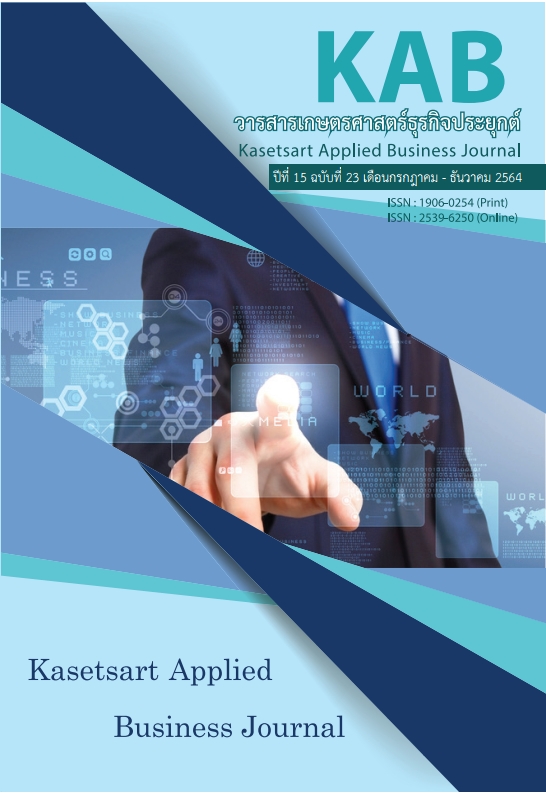โมเดลความสัมพันธ์เชิงสาเหตุของปัจจัยที่มีอิทธิพลต่อความตั้งใจและพฤติกรรมในการสนับสนุนทางการเงินผ่านการระดมทุนสาธารณะเพื่อการลงทุนในวิสาหกิจเพื่อสังคม ในประเทศไทย
Main Article Content
บทคัดย่อ
บทความวิจัยฉบับนี้มีวัตถุประสงค์ เพื่อศึกษาปัจจัยที่มีอิทธิพลต่อความตั้งใจที่จะสนับสนุนทางการเงินผ่านวิธีการระดมทุนสาธารณะในวิสาหกิจเพื่อสังคม เพื่อศึกษาปัจจัยที่มีอิทธิพลต่อความตั้งใจในการแบ่งปันข้อมูลเรื่องการระดมทุนสาธารณะในวิสาหกิจเพื่อสังคม เพื่อศึกษาปัจจัยที่มีอิทธิพลต่อพฤติกรรมที่จะใช้เงินในการสนับสนุนทางการเงินผ่านวิธีการระดมทุนสาธารณะในวิสาหกิจเพื่อสังคม และเพื่อตรวจสอบความสอดคล้องของโมเดลความสัมพันธ์เชิงสาเหตุ อิทธิพลของทัศนคติ การคล้อยตามกลุ่มอ้างอิง บรรทัดฐานทางสังคม การรับรู้ความสามารถในการควบคุมพฤติกรรม การรับรู้ความสามารถของตนเอง สิทธิประโยชน์ทางภาษี ความตั้งใจในการสนับสนุนทางการเงิน ความตั้งใจในการแบ่งปันข้อมูล และพฤติกรรมสนับสนุนทางการเงินผ่านการระดมทุนสาธารณะเพื่อการลงทุนในวิสาหกิจเพื่อสังคม โดยใช้การวิจัยเชิงปริมาณ ซึ่งมีเครื่องมือที่ใช้ในการวิจัย คือแบบสอบถาม และเก็บรวบรวมข้อมูลจากผู้ที่เคยลงทุนผ่านวิธีการระดมทุนสาธารณะในวิสาหกิจเพื่อสังคมในประเทศไทย จำนวน 1,527 ราย
ผลการวิเคราะห์โมเดลสมการโครงสร้าง พบว่าปัจจัยด้านทัศนคติ บรรทัดฐานทางสังคม การรับรู้ความสามารถในการควบคุมพฤติกรรม การรับรู้ความสามารถของตนเอง และสิทธิประโยชน์ทางภาษีมีอิทธิพลทางตรงเชิงบวกต่อความตั้งใจในการสนับสนุนทางการเงินให้กับวิสาหกิจเพื่อสังคม ในขณะที่ปัจจัยด้านการคล้อยตามกลุ่มอ้างอิง ไม่มีอิทธิพลทางบวกต่อความตั้งใจในการสนับสนุนทางการเงินให้กับวิสาหกิจเพื่อสังคม ด้วยวิธีการลงทุนผ่านการระดมทุนสาธารณะ อย่างมีนัยสำคัญทางสถิติที่ 0.05 นอกจากนี้ ยังพบว่าปัจจัยด้านทัศนคติ การคล้อยตามกลุ่มอ้างอิง บรรทัดฐานทางสังคม การรับรู้ความสามารถในการควบคุมพฤติกรรมและการรับรู้ความสามารถของตนเองมีอิทธิพลทางตรงเชิงบวกต่อความตั้งใจในการแบ่งปันข้อมูล ในขณะที่ปัจจัยด้านสิทธิประโยชน์ทางภาษี ไม่มีอิทธิพลทางบวกต่อความตั้งใจในการแบ่งปันข้อมูลเกี่ยวกับการลงทุนในวิสาหกิจเพื่อสังคม ผ่านวิธีการลงทุนสาธารณะ อย่างมีนัยสำคัญทางสถิติที่ 0.05 นอกจากนี้ ความตั้งใจในการสนับสนุนทางการเงิน และความตั้งใจในการแบ่งปันข้อมูล มีอิทธิพลทางตรงเชิงบวกต่อพฤติกรรมสนับสนุนทางการเงิน อย่างมีนัยสำคัญทางสถิติที่ 0.05
Article Details

อนุญาตภายใต้เงื่อนไข Creative Commons Attribution-NonCommercial-NoDerivatives 4.0 International License.
Journal of TCI is licensed under a Creative Commons Attribution-NonCommercial-NoDerivatives 4.0 International (CC BY-NC-ND 4.0) licence, unless otherwise stated. Please read our Policies page for more information...
เอกสารอ้างอิง
เกวลิน มะลิ. (2557). กิจการเพื่อสังคมในประเทศไทย. วารสารเศรษฐศาสตร์และกลยุทธ์การจัดการ (Journal of Economics and Management Strategy), 1(2), 104-112.
บริษัทธรรมธุรกิจ วิสาหกิจเพื่อสังคม. (2563). ที่มาของธรรมธุรกิจ. ค้นจาก http://www.thamturakit.com/about-us-2
ฝ่ายวิชาการ กองกำกับบัญชีธุรกิจ. (2558). Crowdfunding นำมาซึ่งโอกาสใหม่ ๆ ของ CPAs. ค้นจาก https://www.dbd.go.th/download/article/article_20160316162414.pdf
พระราชบัญญัติส่งเสริมวิสาหกิจเพื่อสังคม. (2562). ค้นจาก https://sme.go.th/upload/mod_download/download-
สำนักงานสร้างเสริมกิจการเพื่อสังคมแห่งชาติ. (2554). สมาคมธุรกิจเพื่อสังคม. ค้นจาก https://www.sethailand.org/about
Ajzen, I. (1991). The theory of planned behavior. Organizational Behavior and Human Decision Process, 50(2), 179–211.
Belleflamme, P., Lambert, T., & Schwienbacher, A. (2014). Crowdfunding: Tapping the right crowd. Journal of Business
Venturing, 29(5), 585–609.
Bergamini, T. P., Navarro, C. L. C., & Hilliard, I. (2017). Is crowdfunding an appropriate financial model for social
entrepreneurship?. Academy of Entrepreneurship Journal, 23(1), 44-57.
Bollen, K. A. (1989). Structural Equations with Latent Variables. New York: John Wiley and Sons.
British Council. (2014). UK: The Center for Social Enterprises of the World. Retrieved from http://www.britishcouncil.or.th/programmes/society/social-entrepreneurs/ social-enterprise-uk
Browne, M. W., & Cudeck, R. (1993). Alternative ways of assessing model fit. In K. A. Bollen and J. S. Long (Eds.),
Testing structural equation models (pp. 136-162). Newbury Park, CA: Sage.
Choo, H., Chung, J.E. and Pysarchik, D.T. (2004), “Antecedents to new food product purchasing behavior among innovator groups in India”, European Journal of Marketing, 38(5/6), 608-625.
Diamantopoulos, A. & Siguaw, A. D. (2000). Introducing LISREL: A guide for the uninitiated. London : Sage Publications.
Dekking, Michel. (2005). A Modern Introduction to Probability and Statistics. Springer. pp. 181–19.
Durande-Moreau, A. & Usunier, J. (1999). Time Styles and the Waiting Experience: An Exploratory Study. Journal of Service Research, 2(2), 173-186.
Everitt, B. S., & Skrondal, A. (2010). The Cambridge dictionary of statistics (4th ed). Cambridge, MA: Cambridge University.
Gerber, E. M., & Hui, J. (2013). Crowdfunding: Motivations and deterrents for participation. ACM Trans. Comput.-Hum. Interact, 20(6), 1–32.
Hair, J. F. J., Black, W. C., Babin, B. J., & Anderson, R. E. (2014). Multivariate data analysis (7th ed.). Upper Saddle River, NJ: Pearson.
Hall, K., Alcock, P. & Millar, R. (2012) Start up and sustainability: marketisation and the Social Enterprise Investment Fund in England. Journal of Social Policy, 41(4), 733-749.
Icon Group International. (2013). The 2013 Import and Export Market for Seeders, Planters, Transplanters, Fertilizer Distributors, and Manure Spreaders Excluding Hand Tools in the United Kingdom. Singapore: ICON Group International.
Kim, M. J., & Hall, C. M. (2019). A hedonic motivation model in virtual reality tourism: Comparing visitors and non-
visitors. International Journal of Information Management, 46, 236-249.
Kashif, M., & De Run, E. C. (2015). Money donations intentions among Muslim donors: an extended theory of
planned behavior model. International Journal of Nonprofit and Voluntary Sector Marketing, 20(1), 84–96.
Kashif, M., Shukran, S. S. W., Rehman, M. A. & Sarifuddin, S. (2015). Customer satisfaction and loyalty in Malaysian
Islamic banks: A PAKSERV investigation. International Journal of Bank Marketing, 33(1), 23-40.
Kortleben, H., & nVollmar, B. H. (2012). Crowdinvesting - eine Alternative in der Gründungsfinanzierung?. In: Research
Papers, No. 2012/06 (Hrsg.): PFH Private Hochschule Göttingen.
Leimeister, J. M., & Zogaj, S. (2013). Neue Arbeitsorganisation durch Crowdsourcing: Eine Literaturstudie. Düsseldorf, Hans Böckler Stiftung.
Macht, S. A., & Weatherston, J. (2015). Academic research on crowdfunders: What's been done and what's to come?. Strategic Change, 24(2), 191–205.
Martin, L. (2015). The Promise of the Maker Movement for Education. Journal of Pre-College Engineering Education
Research (J-PEER), 5(1), Article 4.
Melissa, B. (2012). Larrikins: A History. Brisbane: University of Queensland.
Meyskens, M., & Bird, L. (2015). Crowdfunding and value creation. Entrepreneurship Research Journal, 5(2), 155-166.
Mittelman, R., & Rojas-Mendez, J. (2018). Why Canadians give to charity: an extended theory of planned behaviour
model. International Review on Public and Nonprofit Marketing, 15(1).
Mollick, E. (2014). The dynamics of crowdfunding: An exploratory study. Journal of Business Venturing, 29(1), 1–16.
Mueller, F. (1996). Human Resources as Strategic Assets: An Evolutionary Resource-Based Theory. doi: 10.1111/j.1467-6486.1996.tb00171.x
Perezy, L. P., & Egea, P. (2019). About Intentions to Donate for Sustainable Rural Development: An Exploratory Study.
Sustainability, 11(3),765.
Robinson, J. A., Mair, J. & Hockerts K. (Ed). (2009). International Perspective on Social Entrepreneurship. London: Palgrave Macmillan.
Shneor, R., & Munim, Z. H. (2019). Reward crowdfunding contribution as planned behaviour: An extended framework. Journal of Business Research, 103, 56-70.
Short, J. C., Ketchen, D. J., McKenny, A. F., Allison, T. H., & Ireland, R. D. (2017). Research on crowdfunding: Reviewing the (very recent) past and celebrating the present. Entrepreneurship Theory and Practice, 41(2), 149–160.
Smith, J. R., & McSweeney, A. (2007). Charitable giving: The effectiveness of a revised theory of planned behaviour model in predicting 38. donating intentions and behavior. Journal of Community & Applied Social Psychology, 17(5).
Sorbon Dag. (1996). LISREL 8: User’s Reference Guide. Scientific Software International.
Tarkiainen, A., & Sundqvist, S. (2005) Subjective Norms, Attitudes and Intentions of Finnish Consumers in Buying
Organic Food. British Food Journal, 107, 808-822.
Thomson Reuters Foundation. (2015). Inform. Connect. Empower 2015. Retrieved from https://archive.annual-
report.thomsonreuters.com/2015/assets/media/pages/downloads/thomson-reuters-foundation-report-2015.pdf
World Bank. (2015). World Bank annual report 2015 (English). Washington, D.C.: World Bank Group. Retrieved from
http://documents.worldbank.org/curated/en/880681467998200702/World-Bank-annual-report-2015.
Yunus, M. (2007). Creating a World without Poverty: Social Business and the Future of Capitalism. New York: Public Affairs.
Ziegler, T., Shneor, R., Garvey, K., Wenzlaff, K., Yerolemou, N., Zhang, B., & Hao, R. (2018). Expanding horizons: The
rd European alternative finance industry report. Cambridge, UK: Cambridge Centre for Alternative Finance.


